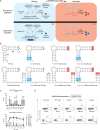Stem Loop Mediated Transgene Modulation in Human T Cells
- PMID: 39642942
- PMCID: PMC11669162
- DOI: 10.1021/acssynbio.4c00152
Stem Loop Mediated Transgene Modulation in Human T Cells
Abstract
Controlling gene expression is useful for many applications, but current methods often require external user inputs, such as the addition of a drug. We present an alternative approach using cell-autonomous triggers based on RNA stem loop structures in the 3' untranslated regions (UTRs) of mRNA. These stem loops are targeted by the RNA binding proteins Regnase-1 and Roquin-1, allowing us to program stimulation-induced transgene regulation in primary human T cells. By incorporating engineered stem loops into the 3' UTRs of transgenes, we achieved transgene repression through Regnase-1 and Roquin-1 activity, dynamic upregulation upon stimulation, and orthogonal tunability. To demonstrate the utility of this system, we employed it to modulate payloads in CAR-T cells. Our findings highlight the potential of leveraging endogenous regulatory machinery in T cells for transgene regulation and suggest RNA structure as a valuable layer for regulatory modulation.
Conflict of interest statement
The authors declare the following competing financial interest(s): D.M., P.C.R., N.C.S., and C.H.J. are co-inventors on a provisional patent describing this system. N.C.S. is a scientific co-founder and holds equity in Bluewhale Bio, is a scientific advisor for Tome Biosciences and Pan Cancer T, and holds equity in Tmunity Therapeutics, and Pfizer Inc. C.H.J. is a scientific co-founder and holds equity in Capstan Therapeutics, Dispatch Biotherapeutics and Bluewhale Bio. C.H.J. serves on the board of AC Immune and is a scientific advisor to BluesphereBio, Cabaletta, Carisma, Cartography, Cellares, Cellcarta, Celldex, Danaher, Decheng, ImmuneSensor, Kite, Poseida, Verismo, Viracta, and WIRB-Copernicus group.
Figures




References
-
- Maude S. L.; Laetsch T. W.; Buechner J.; Rives S.; Boyer M.; Bittencourt H.; Bader P.; Verneris M. R.; Stefanski H. E.; Myers G. D.; et al. Tisagenlecleucel in Children and Young Adults with B-Cell Lymphoblastic Leukemia. N Engl J. Med. 2018, 378, 439–448. 10.1056/NEJMoa1709866. - DOI - PMC - PubMed
Publication types
MeSH terms
Substances
Grants and funding
LinkOut - more resources
Full Text Sources

